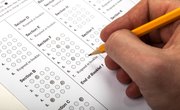The idea behind authentic assessments is to have students demonstrate their knowledge in ways that are much more applicable to life outside of school. Standardized testing, on the other hand, is a more narrowly focused assessment tool. While standardized testing can serve a role in the assessment of student outcomes, authentic assessment has a number of advantages as well.
Assessment Drives Curriculum
When teachers use authentic assessment methods, the assessment drives the curriculum. In other words, rather than teaching students a concept and then testing to see if they have learned it, teachers instead base their lesson plans on the relevant standardized test and then devise a way to “teach to the test.” In traditional assessments, teaching to the test is unwise. Because authentic assessment requires a student to demonstrate understanding, mastering the test is the best way to master the material.
Performing a Real Life Task
In authentic assessments, students are given tasks to perform that have applications in real life rather than just selecting an answer, as is the case on a standardized test. These tasks can range from making a poster and presentation of how a volcano erupts to showing and understanding of probability by creating a game for the school carnival. Performing these tasks may demonstrate a more solid understanding of the material than simply selecting an answer, and they are more relevant to the skills students need outside of school.
Application of Knowledge
By giving students an opportunity to apply their knowledge rather than simply recalling it to answer a question on the test, authentic assessment often tells a teacher more about how much the student really understands. It also allows the students to deepen their understanding and construct new meaning from what they already know because authentic assessment requires more analysis and synthesis of information. While we may need to recall information in our daily lives, our jobs or higher levels of education, we are more often required to apply our knowledge to new situations.
Student Structured
Authentic assessments are structured around students rather than teachers, unlike traditional assessments and standardized testing. Authentic assessments allow students to find a way to demonstrate their knowledge that best suits them. While students might not understand a question on a test, they might be able to explain the answer in a way that the teacher hadn’t thought to ask. Even a structured authentic assessment, like an essay or presentation, allows for more ways to demonstrate understanding than a standardized test does.
Direct Evidence
Authentic assessments give more direct evidence about a student’s knowledge (or lack of it) than a standardized test can. Even when a student answers correctly on a test, the teacher doesn’t know how he arrived at that answer, so the teacher must use indirect evidence (maybe it was just a wild guess). Authentic assessment can give the teacher more direct evidence about how the student arrives at an answer and takes some of the guesswork out of trying to understand how much a student has really learned.
Related Articles
References
Writer Bio
Dan Williams is a former teacher who has written about education since 2008. His work has appeared in a number of publications, including the "Los Angeles Times" and "GlobalPost."











